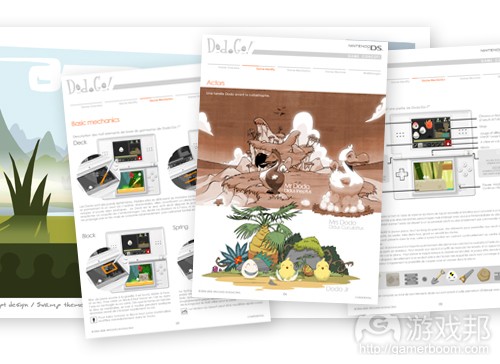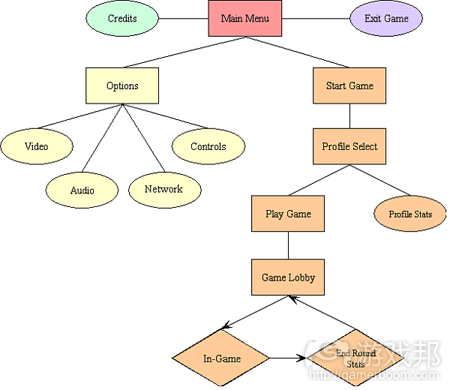解析游戏设计文件应包含的基本内容
作者:Ralph Edwards
在早前的游戏开发中,开发团队的成员人数都较少,所以对于设计文件的需求并不大。由于开发团队规模较小,开发成员经常进行沟通和交流,并且已经对游戏开发各个阶段(包括提出构思,游戏设计等)了如指掌,所以大家对游戏设计文件的简洁易读和清晰性要求并没有那么严格。
而今天许多开发团队都拥有上百名成员,所以他们迫切需要创造一份设计文件去推动团队间的交流,并帮助每一个成员(游戏邦注:包括程序员,制作人,美工,音乐家,市场营销者以及测试者等)明确游戏发展方向。尽管这几年来设计文件变得越来越重要,但是我们仍然需要明确一个普遍且可被接受的设计文件编写标准。事实上,如果你有幸为多家游戏公司服务,你便会发现他们对于设计文件的期望值都不尽相同,甚至在同一家公司中也会出现不同的看法。
以下我将列出一份基本的设计文件所需要的内容。同时你们还需要注意我所列举内容只是作为一种参考,并不需要严格遵从其中标准。根据不同游戏类型,每一个内容的重要性以及它们的作用也会有所不同。以下要点能够帮助你在一开始更好地整合自己的想法,并有效说服开发者接受并使用它。
修改记录
虽然这点很简单,但是对于任何设计文件来说修改记录都是非常重要的一个环节,特别是当你面对的是一些大公司或者根据统一的基础做出改变时。你必须在修改记录中罗列出你在文件中所做出的改变,以确保程序员,美工,制作人或市场营销者能够快速看到新的文件内容,并立刻知晓新的修改内容对于自己工作的影响。
目录
虽然这一点看似很明显,但是却常常遭到忽视。目录非常重要,因为它能够帮助读者快速明确设计文件中包含了哪些部分以及如何快速找到它们。除了提供简单的目录,设计师还可以通过添加标签去区分每个部分,以帮助读者更容易找到自己想要的内容。如果你不能对一个100多页的文件进行区块划分,便会浪费读者大量的时间在文件中反复翻阅。
愿景描述
设计师便是通过愿景描述去描写他们心中的游戏类型。这是一款第一人称射击游戏?是继承《马里奥》灵感的3D平台游戏?还是基于《万智牌》的纸牌游戏?你必须通过愿景描述让所有人知道你想要创造一款什么样的游戏,它与其它游戏类型有什么不同,它的游戏玩法是怎样的,外观和游戏感觉又是怎样的——是黑暗的,现实的,还是模拟现实生活或突出幻想世界等等。
市场营销信息
尽管这主要是市场营销团队的工作,但是对于所有致力于游戏开发的人来说这点都非常重要,因为如此他们才能掌握自己创造的游戏是面向哪些用户。如果游戏是面向儿童,你们就需要尽可能减少暴力和性元素。如果游戏是针对于男性或女性玩家,你就需要在创造任何游戏元素(游戏邦注:包括游戏玩法,游戏图像以及音乐)时始终牢记这一对象。
除此之外设计师还将在这里提及游戏所面向的平台,以及为何这一平台适合他们的游戏,列出同一类型中最成功的游戏,游戏的潜在竞争对手,如何才能取得竞争优势,并根据市场研究去猜测游戏的潜在销量。
内容授权
某些游戏可以直接跳过这一步。但是对于那些需要获得故事,角色,图像,画外音或音乐等内容授权的游戏来说,设计师就需要明确在文件中阐明这一点。
游戏角色
设计师需要详细阐述游戏中的所有角色,从主角开始说起。这种阐述必须包括角色的外观描写,他们的年龄,体重,个性,背景等能让读者立刻认识到这些角色的内容。
除了主角,文件还不能漏掉所有的非玩家角色,包括玩家将在游戏中遭遇到的怪物,好友和敌人等。虽然设计师不需要对这些小角色进行详细描写,但是他们却需要重视游戏中的主要敌人对主角的重要影响。
故事情节
在这一部分设计文件中设计师需要概述游戏故事,即以线性结构模式告诉玩家他们将在游戏中经历什么。其中还包含了故事的阐述模式(游戏邦注:是否同文本,画外音,过场动画或者所有这些方法相结合),以及背景故事或次要情节(即未依附主要故事情节但是却伴随着它而发展的内容)的细节等。
游戏世界
文件的这一部分内容必须让读者能够清楚地了解到游戏世界的相关内容。也就是这里必须包含世界地图,主要城市或地点,游戏中互动以及非互动对象,情境以及每个区域的外貌,居民的类型,世界中的所有事物的重要性以及玩家该如何在这个世界中穿梭着等内容。
游戏玩法
游戏玩法的细节描述便是设计文件中最重要的一大环节。这一部分应该先从核心游戏玩法以及玩家在穿越游戏时所面对的游戏机制的综述展开。设计师需要基于游戏的不同部分完整地绘制出游戏控制,详细地解释清楚游戏界面,明确玩家在小规模和整体规模下的成功和失败标准,具体描写AI行为模式,武器或升级能力,菜单或任何隐藏目标等内容。总之,文件的这一部分必须详细解释玩家所控制的角色所经历的所有内容以及受AI控制的非玩家角色的反应。
除此之外,这一部分还需要阐明游戏中的每个关卡,列出一个通用流程图以呈现玩家如何穿越于不同关卡间,并描绘玩家将在每个关卡遇到哪些合作与挑战等。
除了基础的游戏元素,这一部分还可以用来讨论各种不同的游戏模式,共有哪些模式,这些模式的界面和设计是怎样的以及它们是如何与游戏主体维系在一起。
附录
与目录一样,附录也将对游戏中的细节内容进行总结并帮助读者快速找到这些内容。除了出现在文件最后,并且是通过字母和更细节化的模式表述出来,附录几乎与目录是一样的。
游戏邦注:原文发表于2006年6月20日,所涉事件和数据均以当时为准。(本文为游戏邦/gamerboom.com编译,拒绝任何不保留版权的转载,如需转载请联系:游戏邦)
Game Design 101: The Design Doc
June 20, 2006
by Ralph Edwards
In the early days of game development when teams were based on only a few individuals, there really wasn’t any need for what’s commonly referred to today as a design document. With only a few people working on the development of the game, the need for creating a document that defined in an easy-to-read and detailed fashion wasn’t all that important because the individuals working on the game were always communicating and often already had their hands in every single stage of development, including coming up with the concept and design of the game.
Nowadays with teams working on the development of games in the hundreds, the need of creating a design document that helps communicate the vision and direction of the game to every single member of the team, such as the programmers, producers, artists, musicians, marketers, and testers, has grown exponentially. Although, while the need to have such a document has become immensely important over the years, there still remains to be a universally-defined and accepted standard for how a design document should be written. In fact, if you’ve had the chance to work at different companies within the gaming industry, you will likely have already found that the expectations of how one should be written can vary greatly company-to-company, and in some cases, within a single company.
Nevertheless, here’s a good basic rundown of the items that should be included in a basic design document. And please keep in mind that this is just at sample of topics and what each of the topics should include and should in no way be meant to be followed as a bible. The importance of each item and how critical of a role that it plays in a game will vary greatly based on the game’s genre. What you see below should get you a good start on putting tighter one of your ideas as you shop it around to developers while looking for employment.
Revision History
It’s simple but the revision history is an extremely important part of any design document, particular when dealing with larger companies and when changes are made on a consistent bases. The revision history should list any changes that have been made to the document so that a programmer, artist, producer or marketer can quickly look at the new document and know if any of the new changes directly affect what they may be working on.
Table of Contents
It seems obvious but adding a simple table of contents is often overlooked. It’s important because it lets people know exactly what sections are included in the design document and where to find them quickly. In addition to a simple table of contents, it’s wise to add tabs to the documents that separate each section so information is easy to find for whoever needs to find something. It can be a huge waste of time trying to get to page 100 for the section on the story if it’s not well marked off.
Vision Statement
The vision statement is where the designer will want to describe what kind of game it is. Is it a first-person shooter? A 3D platformer in the vein of Mario? A card game based on Magic the Gathering or whatever is the latest fad? This is where you’ll let everyone know what the game is, how it’s unique from others in the genre, how it plays and how exactly will it look and feel – dark and very realistic, a simulation of real life, animated in a fantasy world, or whatever.
Marketing Information
While this section may be primarily for the marketing team, it also is important to all that are working on the game because it’s key that everyone on the team knows what’s the demographic of the game that’s being made. If it’s for young children, you’ll know to keep the violence and sexuality down some. And if it’s aimed at just men or women, you’ll need to keep that in mind in every single aspect of the game from the gameplay, to the art style, and to the music.
In this section, the designer will also want to make mention of the platform it’s being designed for, why it’s the correct platform for the game, and also list the top performers in the genre being tackled, who the potential competition for the game will be, how this game’s features stacks up against those games and even take an educated guess at potential sales based on market research of games being sold in the genre.
Content Licensing
For some games, you can just skip this section entirely. However, if the title needs a license for its story, characters, likenesses, voiceovers, music, of anything of the like, then here’s where the designer will need to list things out.
Game Characters
Here the designer needs to go into details about all the characters in the game, starting with the main protagonist or protagonists. It should include concepts or descriptions of who the characters look like, their age, their weight, the personality, the backgrounds and everything about them to let the person reading this get to know the character or characters that the game will be based on.
In addition to the game’s main characters, the same needs to be done with all of the NPC (non-player characters) monsters, friends, and enemies that will be encountered throughout the entire game. Not as much details will be needed for those with small roles, but major enemies will need a similar effort to the game’s main stars.
Storyline
The title says it all, this section of the design document is where the designer needs to write out and overview and outline of the story as it unfolds as the player goes through the game in a linear fashion. It should include details on how the story is told – through text, voiceovers, cutscenes, or a combination of these elements – and it should also detail any back story or subplots that may not go along with the game’s main storyline but plays along with it.
Game Universe
This section of the document should give the reader an overview of what exactly the world in the game is all about. It should include maps of the world, the main cities or locations, the interactive and non-interactive objects in it, an idea of the general mood and look of each area, the type of people that inhabit it, just how big everything is inside the world and within each section of the world and how exactly the user travels through it.
Gameplay
The largest and most important section of a designer’s design document is the one that details the gameplay. It should start out with an overview of the core game play and the play mechanics that the game’s user will be using to progress throughout the game. The precise controls needed to be completely mapped out for each different section of the game, the interface needs to be explained in great detail, the conditions for winning and losing on both a small and overall scale needs to be set in stone, and details such as AI behavioral patterns, weapons or ability upgrades and any Easter eggs or hidden secrets should also all be detailed. Basically, this should explain every single thing that happens with the character in control by the user and how the AI-controlled NPC characters will respond to them.
Furthermore, this section needs to explain each of the levels in the game, a general flowchart of how you get from level to level, and what the team and challenges of each level will be presented to the person playing the game.
Beyond just the gameplay elements for playing the base game, this section should also be used to discuss the various different modes of play, what each of these modes are, and how exactly the interface and design will be for these modes will be and how they will play along with the main game.
Appendices
Much like the table of contents, the appendix is pretty much a summary of all the details in the game and how you can quickly find them. It’s just a like the table of contents, except that it appears at the end of the document and has things laid out in an alphabetical and more detailed fashion. (source:IGN)









































 闽公网安备35020302001549号
闽公网安备35020302001549号